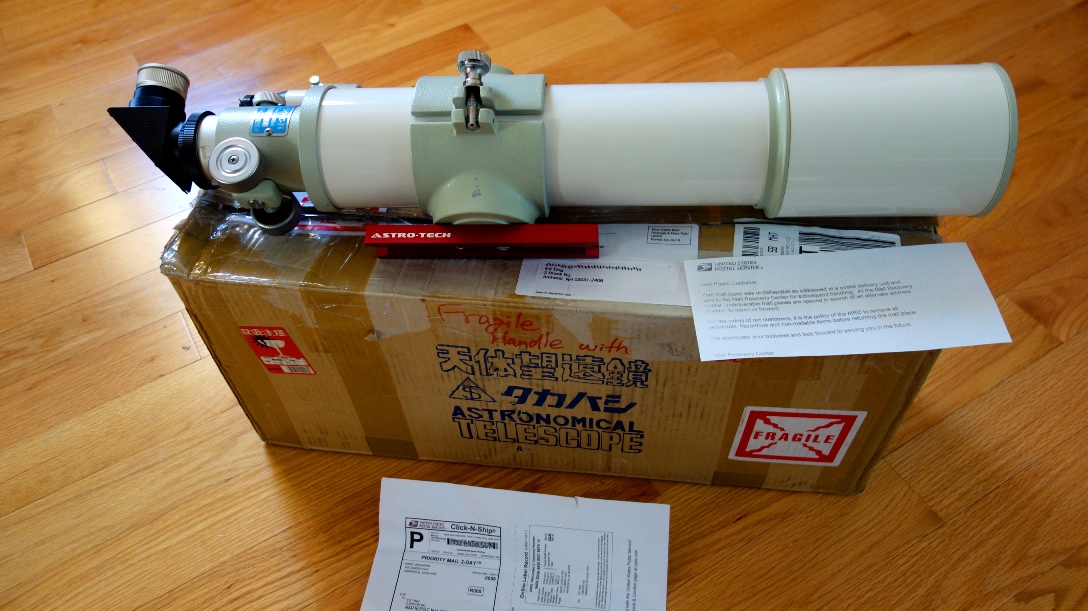
Updated 5/1/14
1) Takahashi FC 76 (2nd Review) 3/10/14
2) Astro-Tech AT10 IN Imaging Newtonian 5/1/14
(76 mm f/8 apochromatic doublet fluorite refractor, OTA only, NLA)
A local club member has a saying that goes something like this: "Ed, if something interesting is going to happen to someone, it will happen to you."
It reminds me of the ancient Chinese curse: "May you live in interesting times." While my adventures in astronomy have given material for this web site, sometimes I wish I could live a normal existence like some of my local astro club members. Take, for example, this Takahashi FC76. I'd wanted one of these ever since I saw Sam's sample about a decade ago. Some experiences stay with you. The best view I've ever had of the Lagoon Nebula, for instance, was through Sam's FC76 with an OIII filter on it. This is an odd combination for this object, but there it was. I've never forgotten that view, and have never forgotten that FC-76. In late 2013, I decided to do something about that memory. I put out a WTB ad on Astromart and within a day, a very nice man from the south responded. I sent him the money, and he shipped the scope via USPS Priority Mail.
And the US Postal Service promptly lost the package.
Now, USPS recently started using tracking numbers for their packages, but in this case, the tracking number did no good. All it showed was that the package got picked up at the originating post office. I started a trace, and visited my local postal office every day for almost a month. I filled out a claims form, and got a message back from the USPS that they were canceling my claim because the form wasn't filled out correctly (the local post office manager told me I'd filled it out just fine.) So that was it. Not only was I out the money, a Takahashi was gone from this world, forever.
Weeks later, a battered package got dumped on my lawn while I was out. I recognized the aspect ratio of the carton, and saw familiar-looking blue Japanese lettering on the side. Could it be? Yes, it was. The FC-76 showed up long after I'd given up on getting it. I opened up the package and the scope appeared to be fine. What apparently happened was that the shipping label got stripped off. In cases like this, the package gets automatically routed to the nearest sorting facility (Atlanta in this case) where the workers open up the package and try to figure out where it should go. It just so happened that the guy who shipped the scope included a copy of the packing label inside the carton. Had he not done so, the scope really would have been lost forever.
Let this be a lesson to anyone out there who buys equipment through the mail: Have the shipper include a copy of the packing slip inside the carton.

The FC -76 in the worn carton. Copy of packing slip at bottom.
I hugged that scope. I called the guys and told them I couldn't make it to that night's observing session without telling them why. And after I used it that night, I brought it upstairs with me later and set it at the foot of the bed on a blanket before I went to sleep. I wasn't ready to have it leave my sight just yet. Later, when my friends saw the FC-76 side by side with the FS-102, someone remarked that I should get out a lawn chair, park myself in front of them with a cold one, and just admire.
I mounted the scope on my CG-4 that night and did some casual observing. The star test revealed minor spherical aberration towards undercorrection. The out of focus star images at 100X look like they split the difference between the 1/8 wave and 1/4 wave diagrams in Suiter's book. Very, very minor false color appeared around bright objects like Sirius at high power.
It's big - many people seeing it live mistake it for a 4" scope. The OTA as shown with the clamshell and the finder weighs 8 lbs. That's a lot for a 3" refractor. In late winter of 2013, I caught M33 from my light-polluted driveway with a 24 mm Panoptic. That's a good sign. Then I looked at M31, M35, M37, M36, M38, M1, M42, M45, the Double Cluster, NGC457, NGC7089, and anything else I could think of. I watched a shadow transit on Jupiter. I split Delta Cygnus with a 5 mm TMB eyepiece - this double is normally a test for a 4" telescope. The only limitations I've found of the scope were the result of me pushing it too far. I had to remind myself constantly that it's a 3" scope, not a 4". I have not been able to split Eta Gemini yet, for example, but my attempts so far indicate that I might have a shot if I get a good enough night.
The FC76 excels at imaging, and the moon composites I've been doing suggest that it doesn't give much up compared to the FS102. When I get some more time and a really clear night, I'm going to pump up the barlows and see how it does on Jupiter and Saturn. I'm also going to try mounting it piggyback on a steady mount with my Canon T3i to do some deep sky imaging.
My telescope buying habits come in phases. When I first started this web site in the late 1990s, I observed mainly through nice refractors. Then I went through a Big-Dob period, and in the period around 2010, I bought almost every Schmidt-Cassegrain I could get my hands on. Now I seem to be back to a refractor phase. The more things change...
It's winter 2014 as I type this - one of the coldest, snowiest winters in history so far. Sagittarius won't anywhere near in sight for months, but when summer gets here, you can bet that I'm going to get out my OIII filter and look at M8.
Because, you know, some memories just stay with you forever.
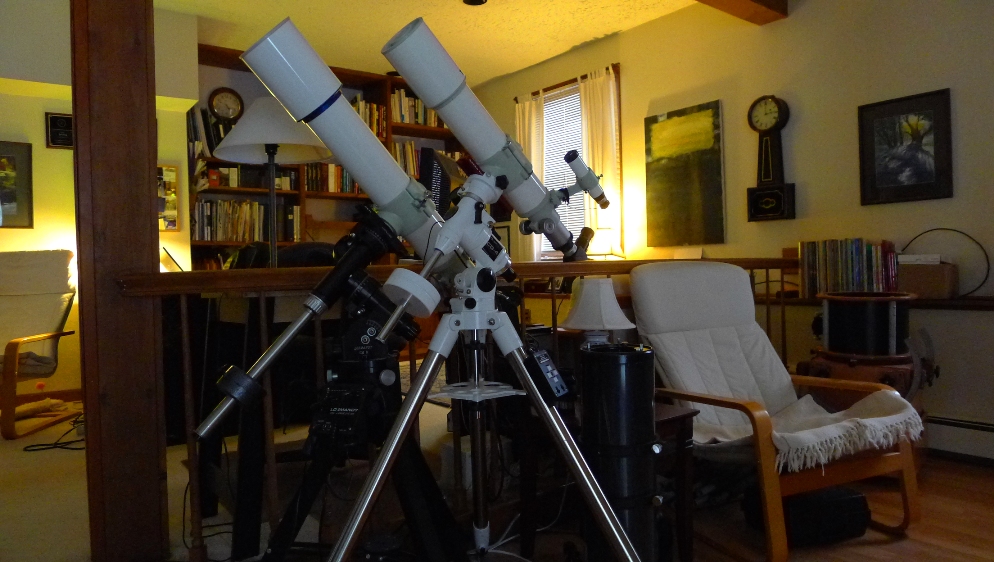
Get a lawn chair and just admire?

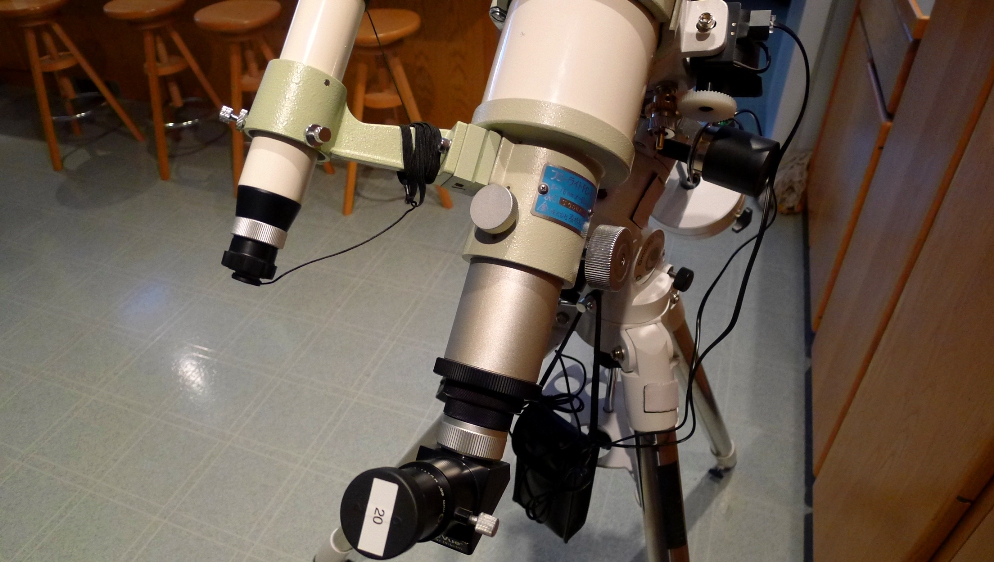
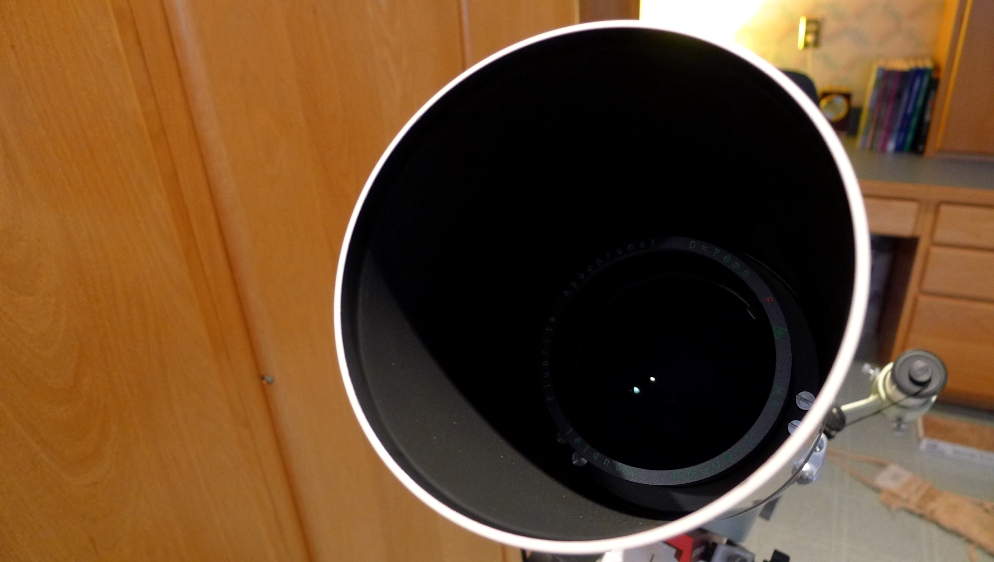
One of life's pleasures - looking down the deep, dark hole of a good apo lens.
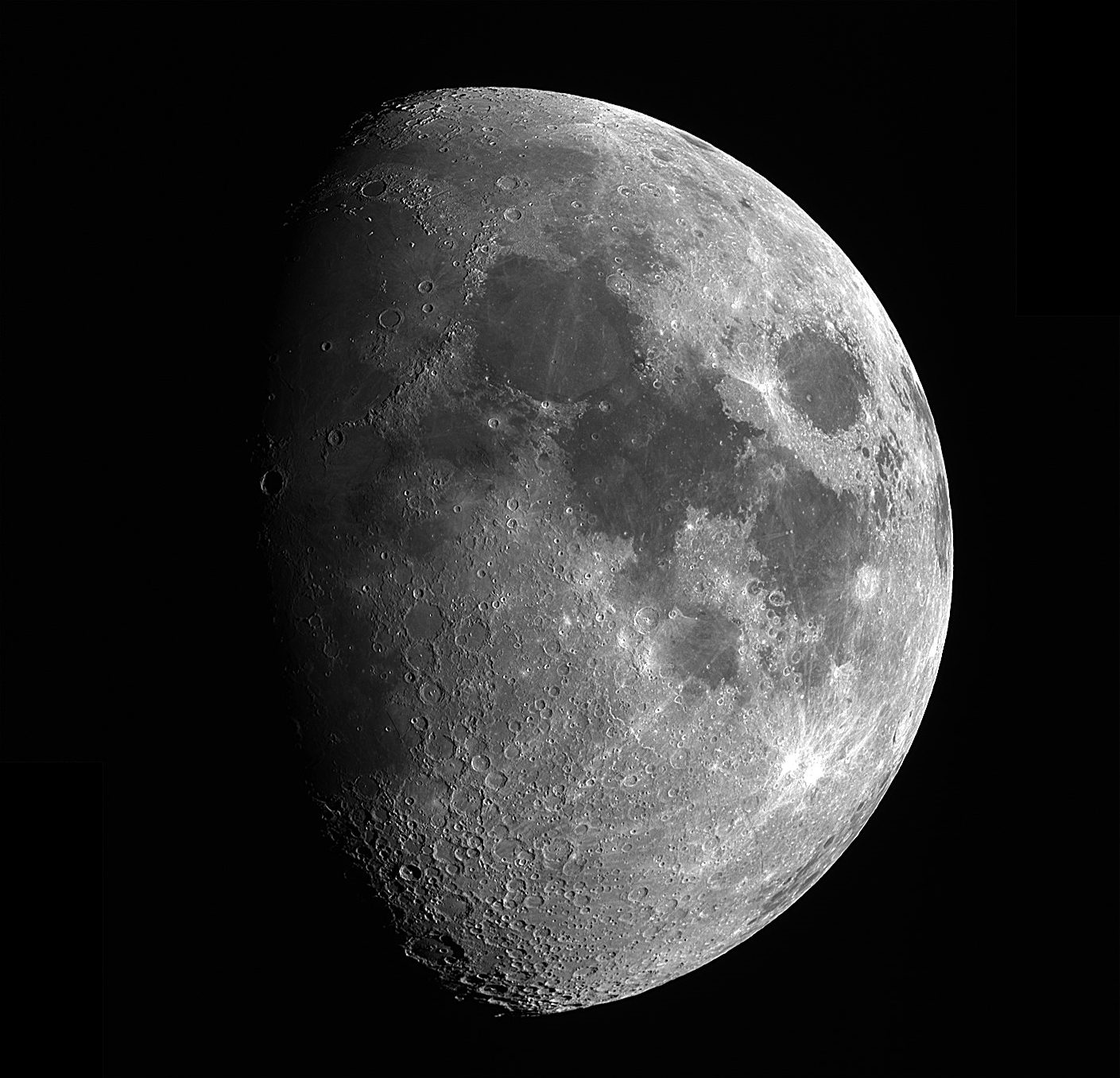
The Moon, November 2013, DMK41, FC-76 @ prime focus
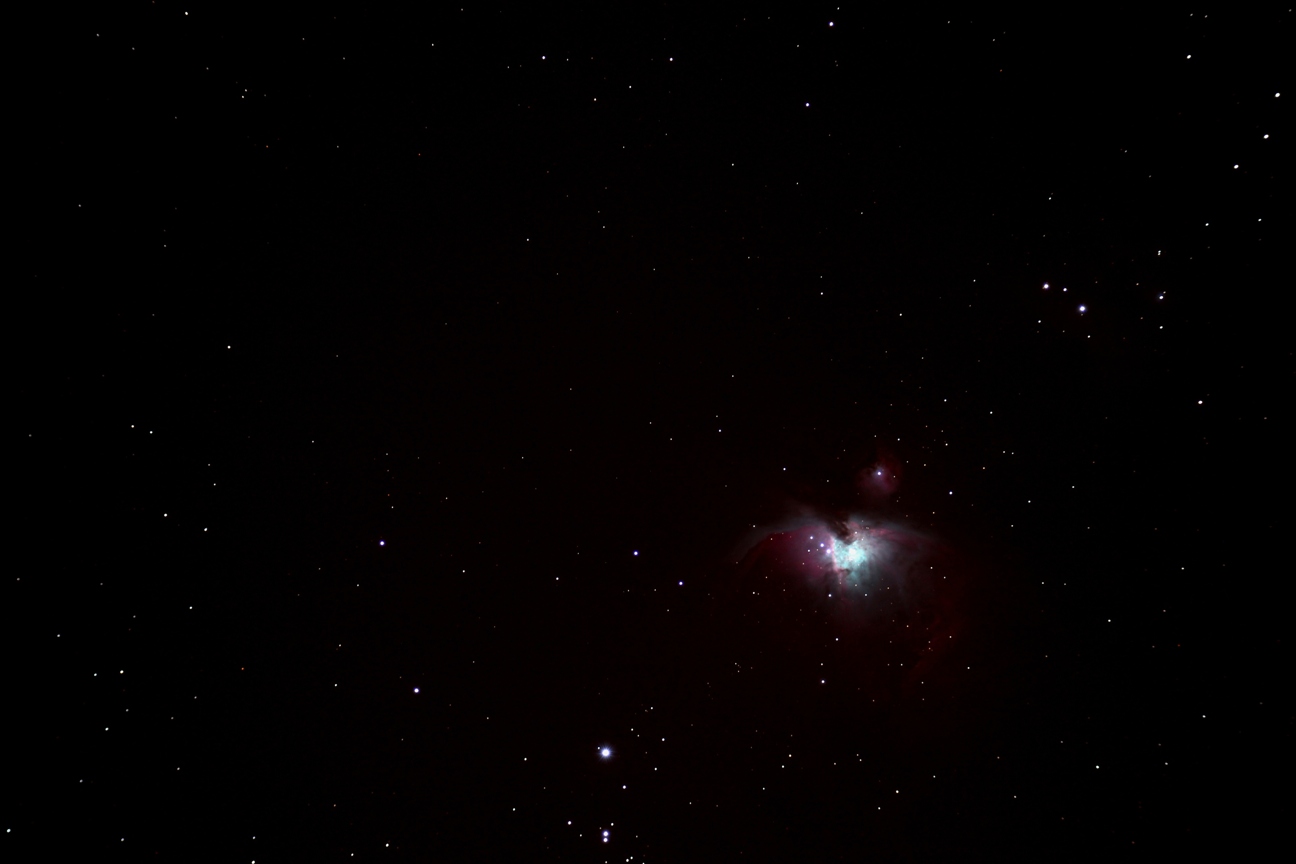
M42, Canon T3i, 2/28/14
2) Astro-Tech AT 10 IN Imaging Newtonian 5/1/14
(10" f/4 Newtonian Reflector, OTA, 8X50 finder, rings, cooling fan, $599 - Orion version is $649)
Late one night, I woke up to hear my cats screaming downstairs. As my cats are both pushing twenty years, screaming is not in their usual daily routine. Something was up. When I got downstairs, my first impression was "there's an intruder in the house." Lurking in the dim shadows stood a large, unmoving, bulky figure. I turned on the lights. There was no intruder. My cats were talking the the Astro-Tech AT10, mounted on my GM-8.
I think the cats and I could be forgiven for making the mistake. The AT10 is HUGE. This rig is a throwback to the 1960s and 1970s, when people put everything on equatorial mounts. And seeing the setup in my house is a good reminder of why we don't do it today. During the test period I sighed just thinking about getting the thing outside. The OTA is listed at thirty pounds, but after you add the rings, plate, finder, and eyepiece, it's more than that, and more importantly, it feels like a lot more than that due to the bulk of the tube. A GM-8 is the largest mount I have right now. It has a listed limit of thirty pounds, which is pushing it, but I didn't have a choice. If you plan on getting one of these, you'd better have a G-11, A Sirius, a CGEM, or something bigger.
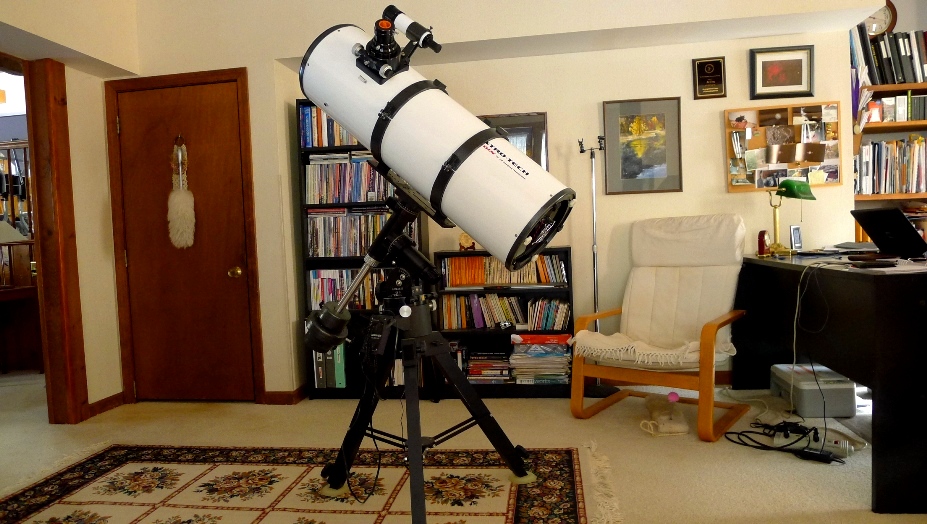
Intruder Alert! The AT10-IN
Although it's billed as an imaging Newtonian, there is nothing wrong with using it purely as a visual instrument. In fact, many of you have written in to tell me that these new 6", 8", and 10" f/4 OTAs sold by Astro-Tech, Orion, and TPO (all appear to the the same, with minor cosmetic and/or accessory differences) are now your favorite visual telescopes. Why? They're well-made, come well-appointed, are short for their apertures, and they cost next to nothing. The 6" version is still only $299 as of this writing. Seeing this 10" version in my house, it is almost impossible to believe that you can get all of this for only $599. I'd think that some enterprising woodworker could get one of these and then make a Dob mount for it. It would lighten the setup, and bring the center of gravity lower to the ground.
Having said this, my previous outings with the 6" and 8" versions of these Imaging Newtonians were mixed. Although I loved the price, the nice focusers, and the build quality, the optics were a little soft. I expected the same with this AT10. I hauled out the rig on several below-zero winter evenings in early 2014 to see how it performed.
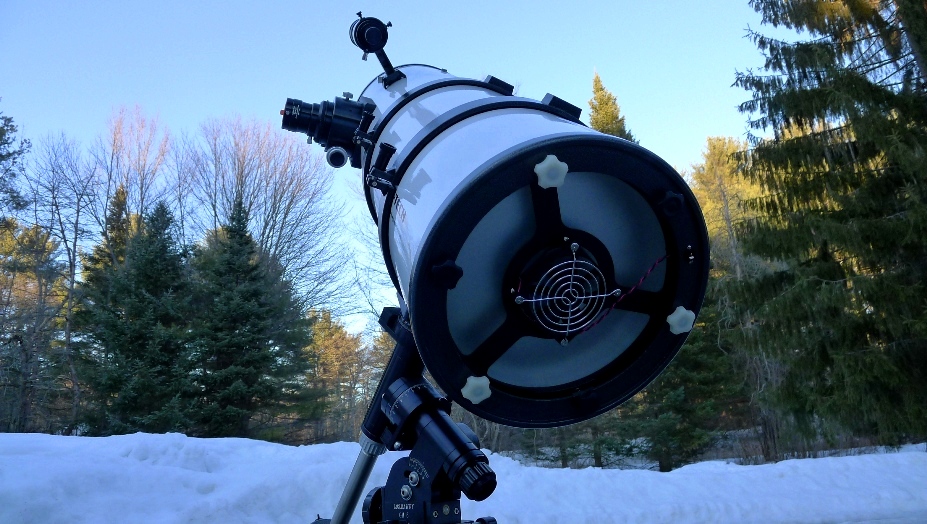
The OTA comes unusually well-appointed for $599, with cooling fan, 8X50 finder, and 3.3" Crayford focuser
Running a star test with a 13 mm Nagler, I got a pleasant shock. The out of focus diffraction patterns were nearly identical. This isn't just the best star test I've seen from one of these f/4 reflectors, it's one of the best star tests I've ever seen from a Newtonian, period. And the scope was operating at f/4, with no field flatteners or coma correctors. Club members Mike T and John R agreed, calling the scope a "keeper" just based on the quality of the mirror. We looked at Jupiter, which was tight and sharp, and the four moons were bright little pinpricks, with a Io taking on a light red hue. Then it was on to the showpiece objects in the winter - M42, M45, M35, M37, M36, M38, and others. The large 10" aperture assured that the tiny clusters near M35 and M38 stood out prominently even with direct vision. I've been playing with a lot of small refractors lately, and it was nice not to have to squint for a change.
As for the GM-8, it wasn't as unsteady as I'd expected, but if I were buying one of these tubes, I'd still want a Sirius or a G-11. I found I had to clamp down very tightly on the axis clutches to keep the tube from wandering at certain angles. Mike T reports that even on his G-11, the AT10's tube is so heavily weighted on the focuser end that he needs to add magnetic counterweights to the radially-opposite end of the tube to keep the OTA properly balanced in all three axes. Other than the size and weight, the only minor complaint I have is the same with any f/4 optical system. With cheap eyepieces, coma creeps into the field at the edges (Astro-Tech does sell an inexpensive coma corrector, if you want one.)
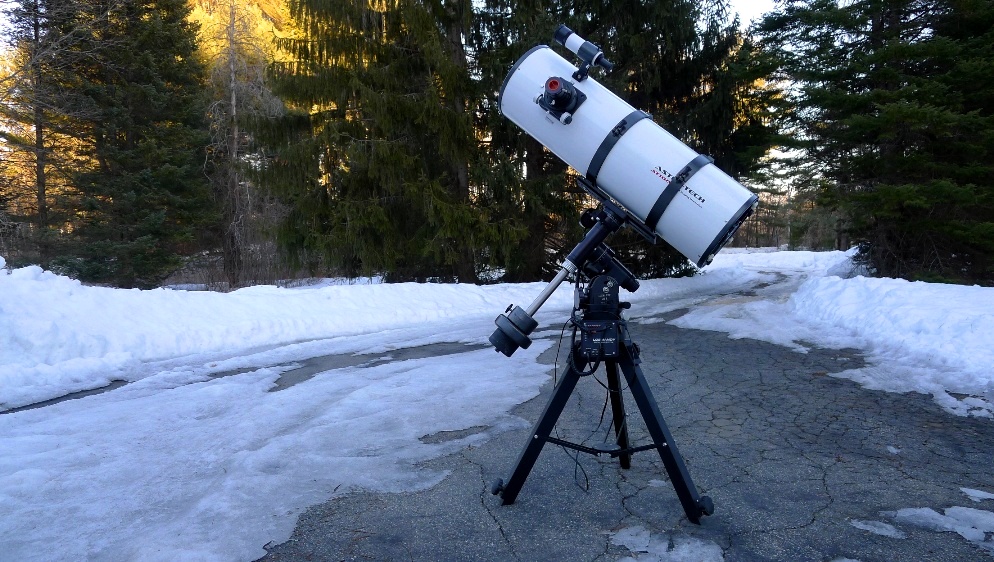
I tried, but I didn't find anything wrong with this scope. Even if I complained about it, I'd think I'd have to flag myself for unsportsmanlike conduct. I mean - stop and think about it. Five hundred and ninety nine dollars. It's less than the cost of one of those fancy new eyepieces. This kind of money barely gets you into the world of the Schmidt-Cassegrain. And if you're looking for an apo? Forget about it - they won't even let you look at a nice refractor for $599.
If you've got an observatory, the AT10 is a no-brainer. For a pittance, you can have a huge tube that will show you and teach you a lot. If you're someone who wants a portable rig, you might want to sit down and think about how motivated you're going to be with this thing once the honeymoon period wears off. Maybe the 8" or 6" versions might be better suited for you. As for the optics, I can't make any guarantees. Maybe I just got one at the top of the bell curve, as others in the series that I've seen have been less than excellent. On the other hand, if they're all this nice, RUN - don't walk, to your nearest computer, and order one before someone gets wise and raises the price.
Astro-Tech AT10 Hots:
Astro-Tech AT10 Nots:
Verdict: A big value